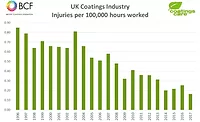Pioneering Improvements in the Coatings Industry
One way to anticipate and address emerging market trends is through open innovation, and selecting the right partners for this innovation is crucial to one’s success.

Coatings formulators and automotive OEMs are continuously seeking strategic supply chain collaborators who can meet their needs on performance, productivity and compliance when it comes to paint. Resources are being cut and the need to drive better-performing, more cost-efficient solutions in coatings formulations is on the rise. One way to anticipate and address these emerging market trends is through open innovation, and selecting the right partners for this innovation is crucial to one’s success.
The concept of open innovation, as it applies to any industry, involves bringing together a team of people throughout the value chain to work to achieve the same, bigger goal. Open innovation is driven by the need to find solutions in the marketplace faster and to rapidly advance technology.
Today more than ever, OEMs and coatings formulators are leveraging the expertise of their strategic suppliers in order to develop the innovative, higher-performing, sustainable coatings technologies required in the 21st century. In the automotive industry, several key players, including Eastman Chemical Company, have embraced the open innovation model and are making strategic investments in personnel and advanced technologies to address the industry’s three main drivers: performance, productivity and compliance.
The following will explore the ways that Eastman and other industry players are contributing to the coatings industry by investing in product development, personnel and technology advances through open innovation.
“One of the first decisions made on the showroom floor is ‘what car looks good?’” says Eastman’s Director of Technology for Specialty Coatings, Dave Allen. “Each of the OEMs really wants to have the brightest colors and sharpest aesthetics that are out there in the industry.”
Back at the factory, appearance is so important in the buying decision, OEMs make it a high priority when building a new facility. The paint-application area of a new automotive plant is the largest capital investment, making up to half the amount of the investment in the entire facility. As a result, there is constant tension and pressure to achieve the premium appearance at lower investment costs and higher productivity. This ‘holy grail’ is what brings OEMs together with other innovators in the supply chain to develop next-generation coatings and application technologies.
“Eastman’s spray facility enables the OEMs and formulators to intelligently turn the knobs in the controls to find the right solution,” states Dr. Mark Nichols, Technical Leader, Materials and Processes Development, at Ford Motor Company and thought leader in advancing coatings technologies. “The benefit of having access to such a facility is to work with a partner in understanding paint processes and collaborating on new technologies and formulations.”
Eastman has launched the Solus™ product line (based on cellulose ester chemistry) to help connect the three primary drivers for global OEMs – performance, productivity and compliance. The in-situ rheology technique developed by researchers at Eastman has helped address some of the critical aspects related to the viscoelastic properties of the coating during initial stages of film formation. Ford has made further modifications to this technique to better understand the rheological behavior in a typical OEM paint application window. In combination with its state-of-the-art spray facility, Eastman is delivering forward-thinking technologies and solutions to the marketplace through active and open innovation.
Dr. Nichols and his team at Ford Research Laboratories continue to lead in innovating technology developments in paint processes. “Everyone is working to find coatings solutions that optimize appearance and keep them a step ahead of compliance requirements,” explains Nichols. “We seek partners that employ an open innovation model so we can work collaboratively to further advance our paint performance.” Eastman’s assets, both in technology and personnel, provide the groundwork for this type of innovation model.
“Even as we see the economy start to rebound, its necessary to work towards better, more competitive solutions as marketplace needs and trends are changing every day,” remarks Allen.
In conclusion, harnessing open innovation throughout the supply chain requires strategic investment in technology and personnel. Eastman’s assets-in its spray facility and researchers-are helping the company to lead the way in innovative thinking towards enhanced coatings technologies and formulations.

Coatings formulators and automotive OEMs are continuously seeking strategic supply chain collaborators who can meet their needs on performance, productivity and compliance when it comes to paint. Resources are being cut and the need to drive better-performing, more cost-efficient solutions in coatings formulations is on the rise. One way to anticipate and address these emerging market trends is through open innovation, and selecting the right partners for this innovation is crucial to one’s success.
The concept of open innovation, as it applies to any industry, involves bringing together a team of people throughout the value chain to work to achieve the same, bigger goal. Open innovation is driven by the need to find solutions in the marketplace faster and to rapidly advance technology.
Today more than ever, OEMs and coatings formulators are leveraging the expertise of their strategic suppliers in order to develop the innovative, higher-performing, sustainable coatings technologies required in the 21st century. In the automotive industry, several key players, including Eastman Chemical Company, have embraced the open innovation model and are making strategic investments in personnel and advanced technologies to address the industry’s three main drivers: performance, productivity and compliance.
The following will explore the ways that Eastman and other industry players are contributing to the coatings industry by investing in product development, personnel and technology advances through open innovation.
The Fast Lane to Innovative Products
In the automotive industry, consumers want a sleek, eye-catching design, and paint is a major contributor to the aesthetics of a vehicle. Eastman is working through open innovation with others in the industry to continually improve the appearance through optimized flake control and enhanced distinctness of image.“One of the first decisions made on the showroom floor is ‘what car looks good?’” says Eastman’s Director of Technology for Specialty Coatings, Dave Allen. “Each of the OEMs really wants to have the brightest colors and sharpest aesthetics that are out there in the industry.”
Back at the factory, appearance is so important in the buying decision, OEMs make it a high priority when building a new facility. The paint-application area of a new automotive plant is the largest capital investment, making up to half the amount of the investment in the entire facility. As a result, there is constant tension and pressure to achieve the premium appearance at lower investment costs and higher productivity. This ‘holy grail’ is what brings OEMs together with other innovators in the supply chain to develop next-generation coatings and application technologies.
Paint in a New Light
Moving towards becoming a preferred innovative supplier, Eastman made a strategic investment in 2007 to create a multi-million dollar, state-of-the-art spray facility, dedicated to fundamental research and application techniques for rheology control and film formation in coatings applications. At the facility, researchers use robotic arms and high-speed cameras to test droplet formation on surfaces, enabling them to tweak the technology and formulation of the paint to optimize performance before it’s applied on the factory floor. The spray facility is currently being used in joint collaborations with major coatings formulators and OEMs to design next generation coatings technologies.“Eastman’s spray facility enables the OEMs and formulators to intelligently turn the knobs in the controls to find the right solution,” states Dr. Mark Nichols, Technical Leader, Materials and Processes Development, at Ford Motor Company and thought leader in advancing coatings technologies. “The benefit of having access to such a facility is to work with a partner in understanding paint processes and collaborating on new technologies and formulations.”
Watching Paint Dry
Technological advances in cellulose-based additives are improving performance as well. These rheology-control additives for automotive coatings can help enable faster dry-to-touch time, improved appearance, and enhanced productivity with up to 50% higher solids than existing solventborne systems. These innovative, multifunctional cellulose-based additives are also helping the industry meet strict compliance standards in the marketplace because of lower-VOCs, reduced energy usage and lower greenhouse gas emissions.Eastman has launched the Solus™ product line (based on cellulose ester chemistry) to help connect the three primary drivers for global OEMs – performance, productivity and compliance. The in-situ rheology technique developed by researchers at Eastman has helped address some of the critical aspects related to the viscoelastic properties of the coating during initial stages of film formation. Ford has made further modifications to this technique to better understand the rheological behavior in a typical OEM paint application window. In combination with its state-of-the-art spray facility, Eastman is delivering forward-thinking technologies and solutions to the marketplace through active and open innovation.
Working Towards the Same Solutions
Eastman researchers are collaborating across the supply chain with formulators and automotive OEMs in leading the industry to find solutions that exceed the marketplace’s needs. Researchers are actively involved in global conferences and meetings as thought leaders, listening to the needs of the industry and discussing new advancements in coatings technologies to address demands throughout the value chain.Dr. Nichols and his team at Ford Research Laboratories continue to lead in innovating technology developments in paint processes. “Everyone is working to find coatings solutions that optimize appearance and keep them a step ahead of compliance requirements,” explains Nichols. “We seek partners that employ an open innovation model so we can work collaboratively to further advance our paint performance.” Eastman’s assets, both in technology and personnel, provide the groundwork for this type of innovation model.
Steps Ahead in the Industry
In the end, it comes down to providing the most cost-effective and best performing solutions to the OEMs.“Even as we see the economy start to rebound, its necessary to work towards better, more competitive solutions as marketplace needs and trends are changing every day,” remarks Allen.
In conclusion, harnessing open innovation throughout the supply chain requires strategic investment in technology and personnel. Eastman’s assets-in its spray facility and researchers-are helping the company to lead the way in innovative thinking towards enhanced coatings technologies and formulations.
Looking for a reprint of this article?
From high-res PDFs to custom plaques, order your copy today!







